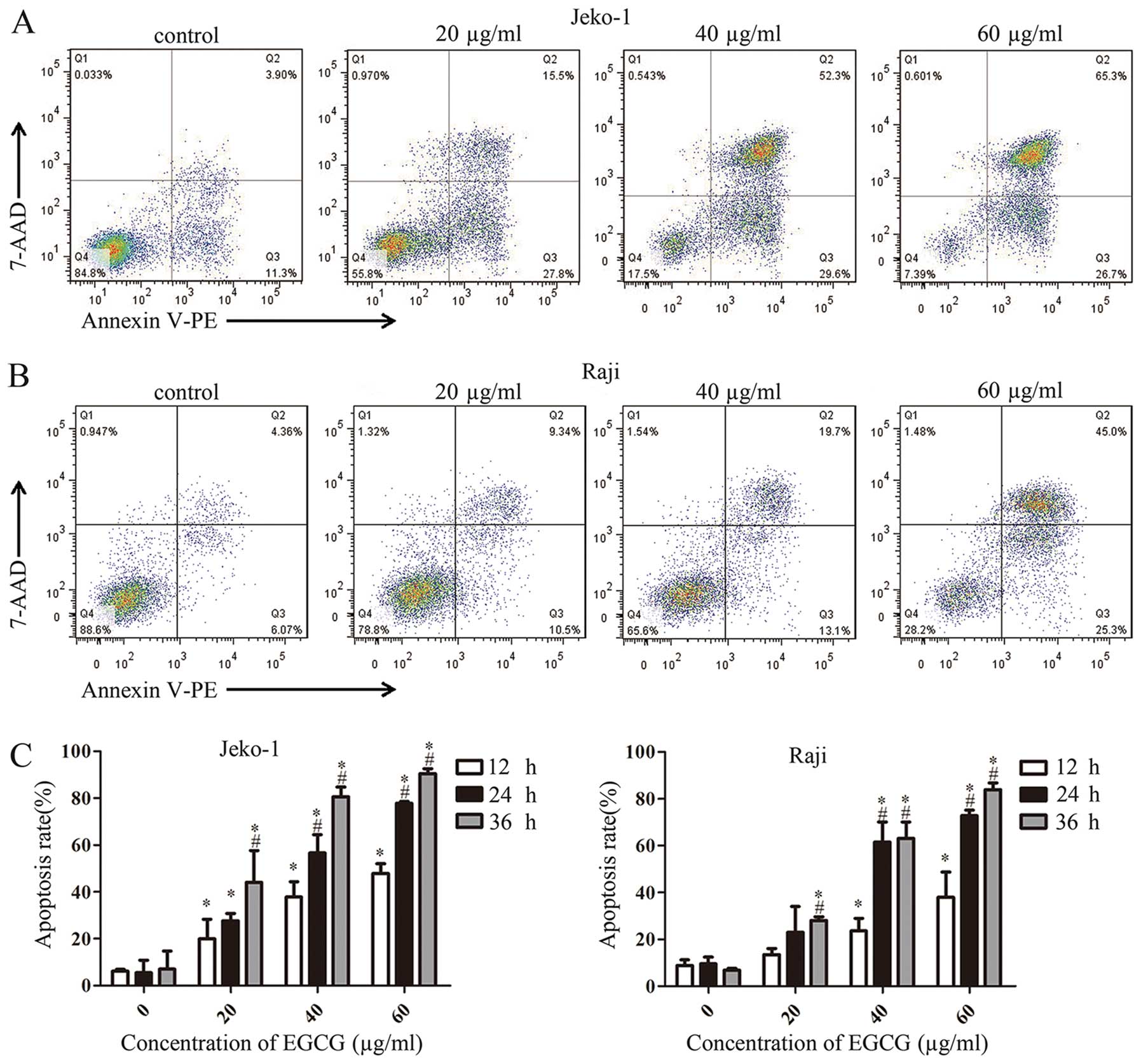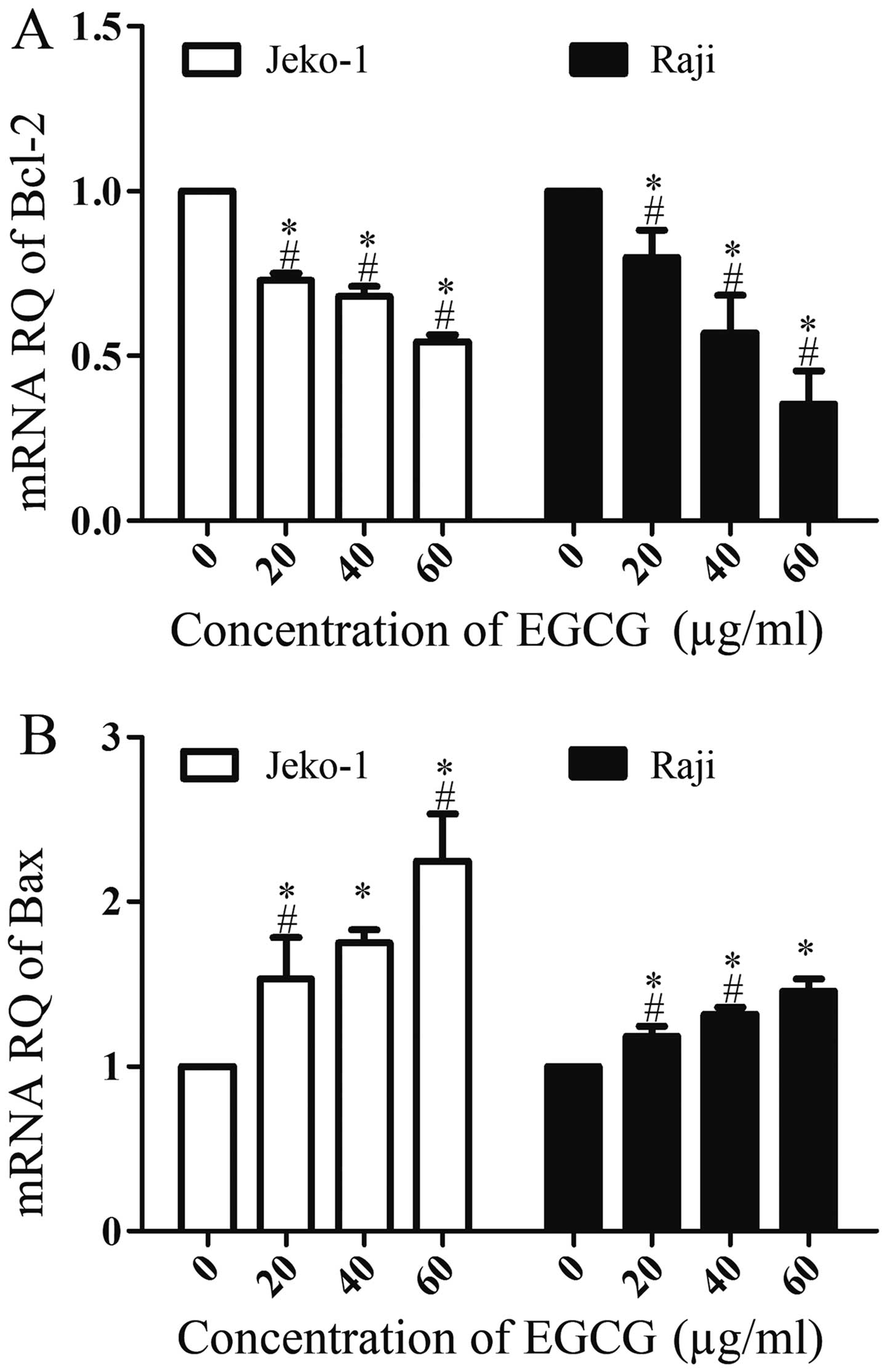|
1
|
Said JW: Aggressive B-cell lymphomas: How
many categories do we need. Mod Pathol. 26(Suppl 1): S42–S56. 2013.
View Article : Google Scholar
|
|
2
|
Vose JM: Mantle cell lymphoma: 2012 update
on diagnosis, risk-stratification, and clinical management. Am J
Hematol. 87:604–609. 2012. View Article : Google Scholar : PubMed/NCBI
|
|
3
|
Bosch F, López-Guillermo A, Campo E,
Ribera JM, Conde E, Piris MA, Vallespí T, Woessner S and Montserrat
E: Mantle cell lymphoma: Presenting features, response to therapy,
and prognostic factors. Cancer. 82:567–575. 1998. View Article : Google Scholar : PubMed/NCBI
|
|
4
|
Li ZJ, Yao C, Liu SF, Chen L, Xi YM, Zhang
W and Zhang GS: Cytotoxic effect of icaritin and its mechanisms in
inducing apoptosis in human burkitt lymphoma cell line. Biomed Res
Int. 2014:3915122014. View Article : Google Scholar : PubMed/NCBI
|
|
5
|
Chang JE and Kahl BS: Current status of
targeted therapies for Mantle cell lymphoma. Drugs. 71:2307–2326.
2011. View Article : Google Scholar : PubMed/NCBI
|
|
6
|
Chen D, Milacic V, Chen MS, et al: Tea
polyphenols, their biological effects and potential molecular
targets. Histol Histopathol. 23:487–496. 2008.PubMed/NCBI
|
|
7
|
Khan N, Afaq F, Saleem M, Ahmad N and
Mukhtar H: Targeting multiple signaling pathways by green tea
polyphenol (−)-epigallocatechin-3-gallate. Cancer Res.
66:2500–2505. 2006. View Article : Google Scholar : PubMed/NCBI
|
|
8
|
Łuczaj W, Waszkiewicz E, Skrzydlewska E
and Roszkowska-Jakimiec W: Green tea protection against
age-dependent ethanol-induced oxidative stress. J Toxicol Environ
Health A. 67:595–606. 2004. View Article : Google Scholar : PubMed/NCBI
|
|
9
|
Betts JW and Wareham DW: In vitro activity
of curcumin in combination with epigallocatechin gallate (EGCG)
versus multidrug-resistant Acinetobacter baumannii. BMC Microbiol.
14:1722014. View Article : Google Scholar : PubMed/NCBI
|
|
10
|
Xu X, Zhou XD and Wu CD: The tea catechin
epigallocatechin gallate suppresses cariogenic virulence factors of
Streptococcus mutans. Antimicrob Agents Chemother. 55:1229–1236.
2011. View Article : Google Scholar :
|
|
11
|
Kuriyama S, Shimazu T, Ohmori K, Kikuchi
N, Nakaya N, Nishino Y, Tsubono Y and Tsuji I: Green tea
consumption and mortality due to cardiovascular disease, cancer,
and all causes in Japan: The Ohsaki study. JAMA. 296:1255–1265.
2006. View Article : Google Scholar
|
|
12
|
Song Y, Manson JE, Buring JE, Sesso HD and
Liu S: Associations of dietary flavonoids with risk of type 2
diabetes, and markers of insulin resistance and systemic
inflammation in women: A prospective study and cross-sectional
analysis. J Am Coll Nutr. 24:376–384. 2005. View Article : Google Scholar : PubMed/NCBI
|
|
13
|
Hu G, Bidel S, Jousilahti P, Antikainen R
and Tuomilehto J: Coffee and tea consumption and the risk of
Parkinson’s disease. Mov Disord. 22:2242–2248. 2007. View Article : Google Scholar : PubMed/NCBI
|
|
14
|
Moseley VR, Morris J, Knackstedt RW and
Wargovich MJ: Green tea polyphenol epigallocatechin 3-gallate,
contributes to the degradation of DNMT3A and HDAC3 in HCT 116 human
colon cancer cells. Anticancer Res. 33:5325–5333. 2013.PubMed/NCBI
|
|
15
|
Muthusami S, Prabakaran DS, An Z, Yu JR
and Park WY: EGCG suppresses Fused Toes Homolog protein through p53
in cervical cancer cells. Mol Biol Rep. 40:5587–5596. 2013.
View Article : Google Scholar : PubMed/NCBI
|
|
16
|
Singh T and Katiyar SK: Green tea
polyphenol, (−)-epigallocatechin-3-gallate, induces toxicity in
human skin cancer cells by targeting β-catenin signaling. Toxicol
Appl Pharmacol. 273:418–424. 2013. View Article : Google Scholar : PubMed/NCBI
|
|
17
|
Takahashi A, Watanabe T, Mondal A, Suzuki
K, Kurusu-Kanno M, Li Z, Yamazaki T, Fujiki H and Suganuma M:
Mechanism-based inhibition of cancer metastasis with
(−)-epigallocatechin gallate. Biochem Biophys Res Commun. 443:1–6.
2014. View Article : Google Scholar
|
|
18
|
Sakamoto Y, Terashita N, Muraguchi T,
Fukusato T and Kubota S: Effects of epigallocatechin-3-gallate
(EGCG) on A549 lung cancer tumor growth and angiogenesis. Biosci
Biotechnol Biochem. 77:1799–1803. 2013. View Article : Google Scholar : PubMed/NCBI
|
|
19
|
Braicu C, Gherman CD, Irimie A and
Berindan-Neagoe I: Epigallocatechin-3-Gallate (EGCG) inhibits cell
proliferation and migratory behaviour of triple negative breast
cancer cells. J Nanosci Nanotechnol. 13:632–637. 2013. View Article : Google Scholar : PubMed/NCBI
|
|
20
|
Gupta S, Hastak K, Afaq F, Ahmad N and
Mukhtar H: Essential role of caspases in
epigallocatechin-3-gallate-mediated inhibition of nuclear factor
kappa B and induction of apoptosis. Oncogene. 23:2507–2522. 2004.
View Article : Google Scholar
|
|
21
|
Gao Y, Li W, Jia L, Li B, Chen YC and Tu
Y: Enhancement of (−)-epigallocatechin-3-gallate and
theaflavin-3-3′-digallate induced apoptosis by ascorbic acid in
human lung adenocarcinoma SPC-A-1 cells and esophageal carcinoma
Eca-109 cells via MAPK pathways. Biochem Biophys Res Commun.
438:370–374. 2013. View Article : Google Scholar : PubMed/NCBI
|
|
22
|
Liu S, Wang XJ, Liu Y and Cui YF:
PI3K/AKT/mTOR signaling is involved in
(−)-epigallocatechin-3-gallate-induced apoptosis of human
pancreatic carcinoma cells. Am J Chin Med. 41:629–642. 2013.
View Article : Google Scholar
|
|
23
|
Cotter TG: Apoptosis and cancer: The
genesis of a research field. Nat Rev Cancer. 9:501–507. 2009.
View Article : Google Scholar : PubMed/NCBI
|
|
24
|
Kumar S: Caspase function in programmed
cell death. Cell Death Differ. 14:32–43. 2007. View Article : Google Scholar
|
|
25
|
Tsujimoto Y: Bcl-2 family of proteins:
Life-or-death switch in mitochondria. Biosci Rep. 22:47–58. 2002.
View Article : Google Scholar : PubMed/NCBI
|
|
26
|
Li W, Nie S, Yu Q and Xie M:
(−)-Epigallocatechin-3-gallate induces apoptosis of human hepatoma
cells by mitochondrial pathways related to reactive oxygen species.
J Agric Food Chem. 57:6685–6691. 2009. View Article : Google Scholar : PubMed/NCBI
|
|
27
|
Wu PP, Kuo SC, Huang WW, Yang JS, Lai KC,
Chen HJ, Lin KL, Chiu YJ, Huang LJ and Chung JG:
(−)-Epigallocatechin gallate induced apoptosis in human adrenal
cancer NCI-H295 cells through caspase-dependent and
caspase-independent pathway. Anticancer Res. 29:1435–1442.
2009.PubMed/NCBI
|
|
28
|
Shen X, Zhang Y, Feng Y, Zhang L, Li J,
Xie YA and Luo X: Epigallocatechin-3-gallate inhibits cell growth,
induces apoptosis and causes S phase arrest in hepatocellular
carcinoma by suppressing the AKT pathway. Int J Oncol. 44:791–796.
2014.PubMed/NCBI
|
|
29
|
Ryu DS, Kim SH, Kwon JH and Lee DS:
Orostachys japonicus induces apoptosis and cell cycle arrest
through the mitochondria-dependent apoptotic pathway in AGS human
gastric cancer cells. Int J Oncol. 45:459–469. 2014.PubMed/NCBI
|
|
30
|
Li J, Zhang F and Wang S: A polysaccharide
from pomegranate peels induces the apoptosis of human osteosarcoma
cells via the mitochondrial apoptotic pathway. Tumour Biol.
35:7475–7482. 2014. View Article : Google Scholar : PubMed/NCBI
|
|
31
|
Benarba B, Meddah B and Aoues A: Bryonia
dioica aqueous extract induces apoptosis through mitochondrial
intrinsic pathway in BL41 Burkitt’s lymphoma cells. J
Ethnopharmacol. 141:510–516. 2012. View Article : Google Scholar : PubMed/NCBI
|
|
32
|
Hazawa M, Takahashi K, Sugata S and
Kashiwakura I: (−)-Epigallocatechin-3-O-gallate induces
nonapoptotic cell death in leukemia cells independent of the 67 kDa
laminin receptor. J Nat Prod. 74:695–700. 2011. View Article : Google Scholar : PubMed/NCBI
|
|
33
|
Islam S, Islam N, Kermode T, Johnstone B,
Mukhtar H, Moskowitz RW, Goldberg VM, Malemud CJ and Haqqi TM:
Involvement of caspase-3 in epigallocatechin-3-gallate-mediated
apoptosis of human chondrosarcoma cells. Biochem Biophys Res
Commun. 270:793–797. 2000. View Article : Google Scholar : PubMed/NCBI
|
|
34
|
Talanian RV, Quinlan C, Trautz S, Hackett
MC, Mankovich JA, Banach D, Ghayur T, Brady KD and Wong WW:
Substrate specificities of caspase family proteases. J Biol Chem.
272:9677–9682. 1997. View Article : Google Scholar : PubMed/NCBI
|
|
35
|
Lee YK, Bone ND, Strege AK, Shanafelt TD,
Jelinek DF and Kay NE: VEGF receptor phosphorylation status and
apoptosis is modulated by a green tea component,
epigallocatechin-3-gallate (EGCG), in B-cell chronic lymphocytic
leukemia. Blood. 104:788–794. 2004. View Article : Google Scholar : PubMed/NCBI
|
|
36
|
Debatin KM and Krammer PH: Death receptors
in chemotherapy and cancer. Oncogene. 23:2950–2966. 2004.
View Article : Google Scholar : PubMed/NCBI
|
|
37
|
Yu DY, Zhao QL, Furuta M, Todoriki S,
Izumi K, Yamakage K, Matsumoto K, Nomura T and Kondo T: Molecular
mechanisms of apoptosis induction by 2-dodecylcyclobutanone, a
radiolytic product of palmitic acid, in human lymphoma U937 cells.
Apoptosis. 17:636–645. 2012. View Article : Google Scholar : PubMed/NCBI
|
|
38
|
Hayakawa S, Saeki K, Sazuka M, Suzuki Y,
Shoji Y, Ohta T, Kaji K, Yuo A and Isemura M: Apoptosis induction
by epigallocatechin gallate involves its binding to Fas. Biochem
Biophys Res Commun. 285:1102–1106. 2001. View Article : Google Scholar : PubMed/NCBI
|
|
39
|
Ola MS, Nawaz M and Ahsan H: Role of Bcl-2
family proteins and caspases in the regulation of apoptosis. Mol
Cell Biochem. 351:41–58. 2011. View Article : Google Scholar : PubMed/NCBI
|
|
40
|
Reed JC, Jurgensmeier JM and Matsuyama S:
Bcl-2 family proteins and mitochondria. Biochim Biophys Acta.
1366:127–137. 1998. View Article : Google Scholar : PubMed/NCBI
|
|
41
|
Lee JH, Jeong YJ, Lee SW, Kim D, Oh SJ,
Lim HS, Oh HK, Kim SH, Kim WJ and Jung JY: EGCG induces apoptosis
in human laryngeal epidermoid carcinoma Hep2 cells via mitochondria
with the release of apoptosis-inducing factor and endonuclease G.
Cancer Lett. 290:68–75. 2010. View Article : Google Scholar
|
|
42
|
Iwasaki R, Ito K, Ishida T, Hamanoue M,
Adachi S, Watanabe T and Sato Y: Catechin, green tea component,
causes caspase-independent necrosis-like cell death in chronic
myelogenous leukemia. Cancer Sci. 100:349–356. 2009. View Article : Google Scholar : PubMed/NCBI
|
|
43
|
Das A, Banik NL and Ray SK: Mechanism of
apoptosis with the involvement of calpain and caspase cascades in
human malignant neuroblastoma SH-SY5Y cells exposed to flavonoids.
Int J Cancer. 119:2575–2585. 2006. View Article : Google Scholar : PubMed/NCBI
|
















